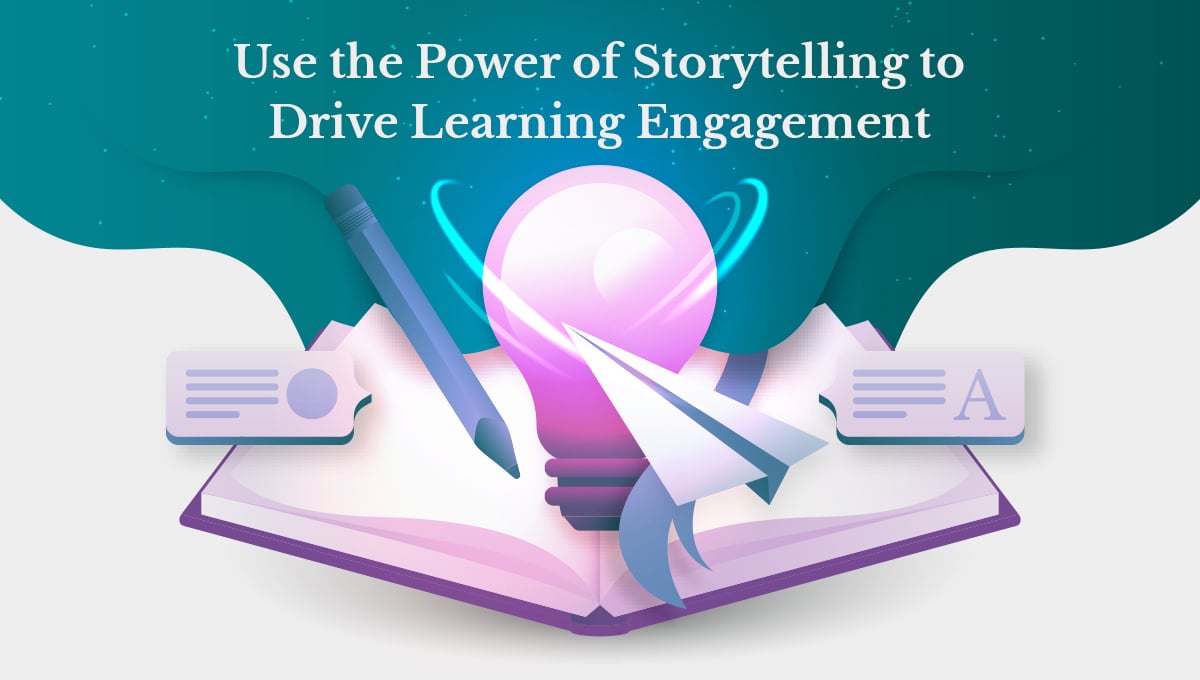
Nothing draws our attention better than a gripping story. And what else is not a story?
Think about our history; is it not a collection of stories about kings, wars, love, and strife? What is our tradition, if not the values we learn and pass on in the form of stories? Is it not the technique of storytelling that made the whole world crazy about movies?
Stories form an integral part of our human interactions. Our conversations involve stories in which we make sense of our experiences.
Storytelling in eLearning
With a growing demand to upskill and the need to keep your organizations and workforce compliant, you may load one curriculum after another upon your learners, only to see poor engagement, low completion rates, and higher frustration on the learners.
Your people want learning to be an experience that engages their hearts and minds.
Storytelling in eLearning can captivate your learners, create an immersive environment, and lead to a behavioral change, one that initiates the application of the skills learned and improves performance. 
You can turn the driest courses into compelling narratives that boost engagement and knowledge retention, sustain interest, and trigger action.
How Storytelling Works in eLearning
Complexity to lucidity.
Storytelling can mold complex content into coherent narratives. Learners get involved in the story and learn without effort.
Relate by relevance.
Is it not easier to remember the flow of events in a story and its consequences than memorize a massive list of facts that do not relate to you in any way? Storytelling puts your learners in the shoes of the characters, relates to them personally, and triggers them to learn by making choices.
Decrease Boredom. Increase Memory.
With different settings and scenes, storytelling can remove tedium. Moreover, it sparks your learners' emotions, and triggers them to act, anticipating a positive outcome. The result makes an impact on their minds and the learning sticks.
Educate via Entertainment.
Storytelling features like setting, characters, plot, and humor educate by entertaining, but be on guard that lest you just entertain and forget to educate.

Storytelling & Neurolearning
Storytelling is also the most productive element of Neurolearning.
Neuro learning is a learning methodology that focuses on how the human brain processes information. It uses storytelling to optimize the learning experience, enhances understanding, and improves information recall.
This methodology lays great emphasis on engaging learners' emotions, so the brain actively creates coherent narratives and processes them.
Learning the Ingredients of Storytelling
When you are trying to integrate storytelling in your courses, make sure it comes out as an experience your learners want to repeat. The critical ingredients of storytelling are those elements that capture and sustain your learners' interest:
- Setting - the place where a story or a scene in a story happens.
- Plot - a flow of events in a story, novel or a film.
- Characters - imaginary people who act out a role in a story, novel, or film.
- Theme - the central idea of the story that recurs throughout the plot.
- Humor - a mood created using words and characters to spark laughter.
- Goals - learning objectives that learners are to meet.

Best Practices in Storytelling in eLearning
Know your Audience
Knowing your audience is a top priority in building your eLearning courses, but you should even be keener about your audience when you are trying to knit all your course content into a story. Stories succeed and fail, depending on how your audience relates to the story. Some of the critical questions to which you should answer are:
- What kind of emotions can trigger your audience to act?
- What are the most favorite story genres of most of your audience?
- Will your audience relate to the protagonist in the story?
Conducting surveys and speaking directly with your audience can help you grasp more insights about them.
Serve the Need, Not Passion
You cannot always use storytelling in your eLearning just because you love building stories, or the last course you offered was a hit. Analyse the need and determine if using storytelling will give you the learning outcomes you are seeking.
Understand your learners and tap into their minds. Work with your team to analyze all the available options and review what successful people in the industry suggest. Once you are all clear on insights that support your choice, go ahead and make it a reality.
Storytelling is captivating, but complex in its creation. Patience, creativity, and understanding of your audience can become your best co-creators. Let them join you as you begin to use the technique of storytelling in eLearning.
PhenomᵉCloud is a comprehensive technology solutions provider committed to empowering businesses to overcome challenges, enhance their workforce capabilities, and achieve superior outcomes.


Leave a Comment